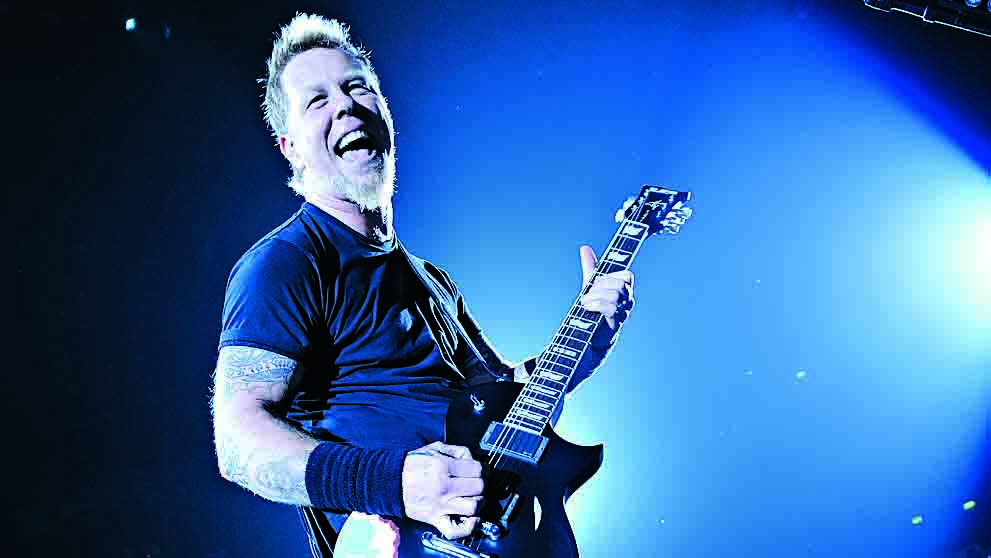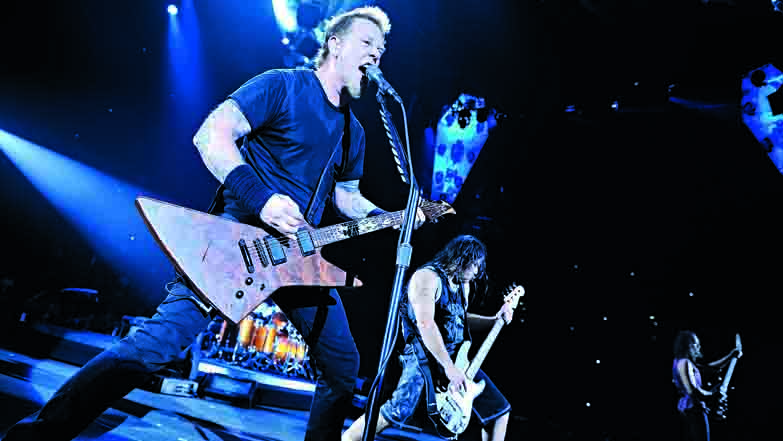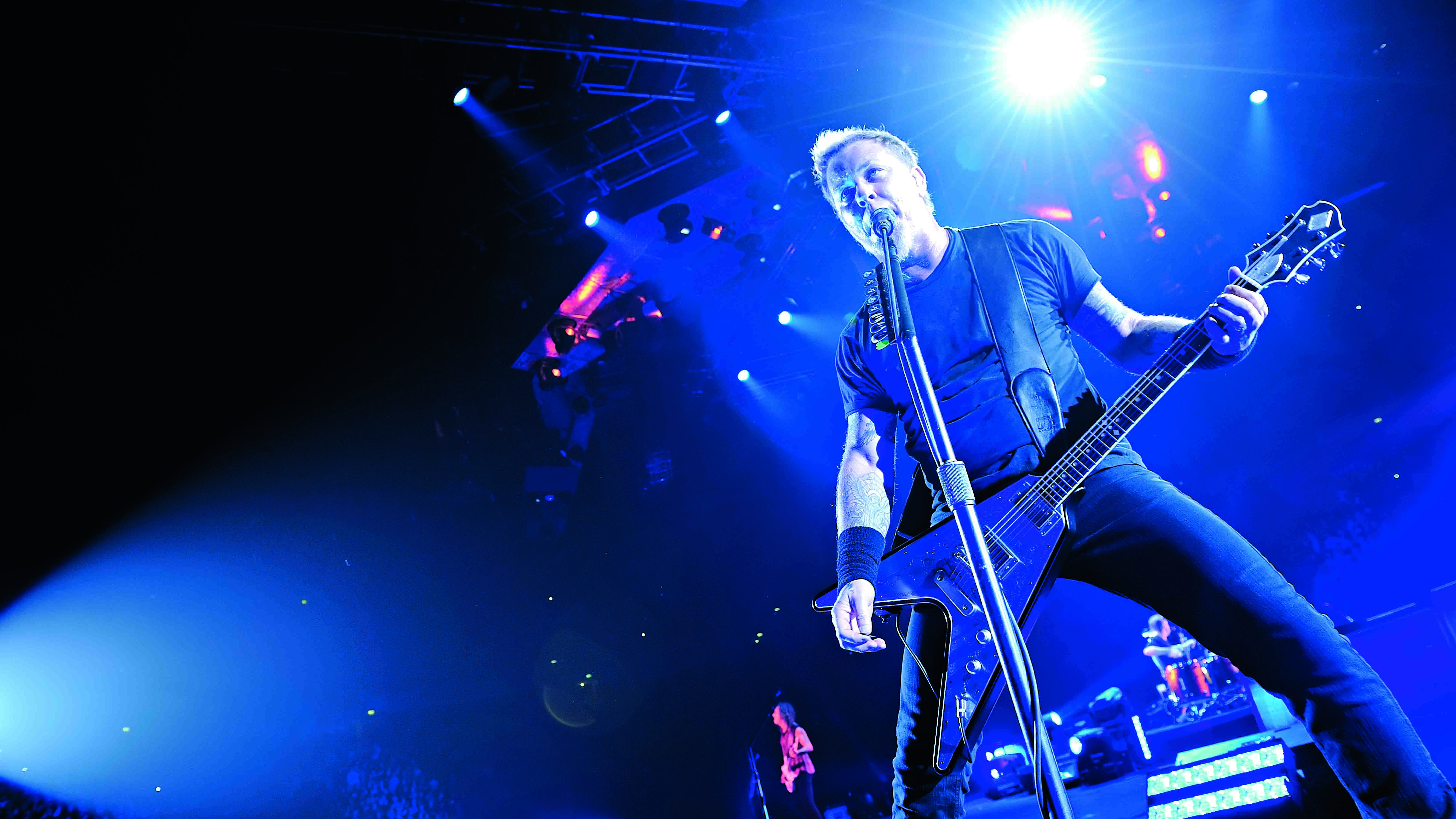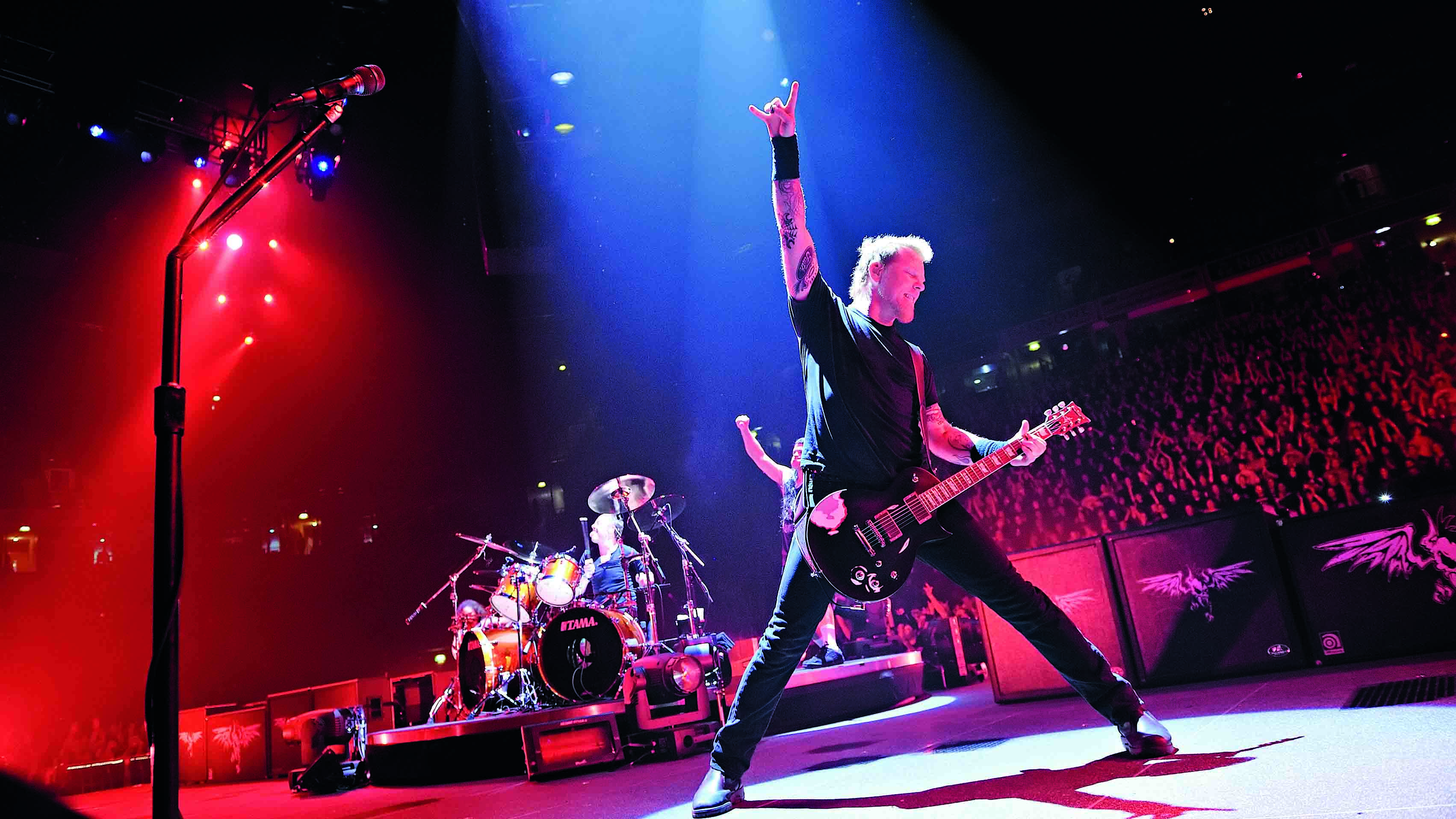Classic interview: James Hetfield – "I’m able to show Lars some drum stuff and he’s able to show me riff stuff"
The Metallica legend talks rhythm, riffs and whether alternate picking is a cop-out back in 2009

Back in 2009 the cover star for Total Guitar's rhythm issue was one of the greatest rhythm guitarists of all-time. Metallica's James Hetfield doesn't just have a right hand like a traction engine, he's written the riff benchmarks by which other metal guitarists measure their own. It's a very high bar and Papa Het revealed the mindset and discipline behind it.
To begin with, James, when did you get interested in becoming a musician?
“I started taking piano lessons when I was about eight years old because my mum saw me basically playing drums on a piano at someone’s house once and thought, ‘Oh, he’s a musician!’ So I took some lessons at some old lady’s house, which stunk, but she gave me cookies at the end.
"I took those lessons for three years and thought, ‘This sucks, I’m not learning any Aerosmith songs here!’ I was playing sh*t I had no care for, so I graduated to guitar because my brothers, who are 10 years older than me, were in bands at the time so there was always a drum kit, piano and guitar sitting around the house. They were like toys. I loved hard rock so I picked up the guitar.”

Onstage, the only thing Lars has got in his ear monitors is my guitar and some vocals. So I’m kinda keeping the tempo of the song and he’s able to get a little crazier on the drums
When you started out on guitar, did you think you’d play rhythm parts or did you just want to learn to play solos?
“When I started playing guitar, I would fiddle around with pretty much everything. I was trying out different rhythms and trying to play [Aerosmith guitarist] Joe Perry solos, but then I just started gravitating more towards rhythm because of guys like Tony Iommi, Rudolf Schenker of the Scorpions, and even AC/DC. You know, very rhythm-based stuff.
"And then later I got into riffing as, to me, that’s what makes a song great. If you’ve got a great riff you’ve got a great song. Some dude can do an amazing solo, but if it’s over a crappy riff the song’s still gonna be crap. A riff is the meat of the song.”
Get the MusicRadar Newsletter
Want all the hottest music and gear news, reviews, deals, features and more, direct to your inbox? Sign up here.
You’re famed for your rhythm playing, but how would you define your style?
“Percussive. I love playing drums, so a lot of the rhythms come from beats that I have in my head. A lot of times when you’re doing a rhythm and the drums play along exactly to that rhythm, it’s less effective. I see that a lot in certain bands these days: ‘here’s the guitar riff and the kick and snare are doing the exact same thing’.
"With Metallica, Lars [Ulrich] is always playing a little against the riff. It’s almost like I’m the drummer and he does counter beats to the rhythm. Onstage, the only thing Lars has got in his ear monitors is my guitar and some vocals. So I’m kinda keeping the tempo of the song and he’s able to get a little crazier on the drums.”
How much of your rhythm style can be attributed to Lars’ drumming?
“Quite a bit because, as I say, I have a lot of room to lay down. I might not be able to be as free as possible on some stuff because when I get loose everything goes a little wobbly! But I’m able to show Lars some drum stuff and he’s able to show me riff stuff, you know? I’m a frustrated drummer and he’s a frustrated singer-guitarist!
So it’s really great that we’re able to accept each other’s dreams that way and see it as a positive thing, not just, ‘Get outta my territory!’”

On Load and ReLoad we tried to get a little looser, a little bluesier. Greasy is the word. It didn’t give me the same feel.
Who inspired your rhythmic riffing style?
“My rhythm gods are Tony Iommi, Rudolf Schenker and Malcolm Young – guys who just keep it steady. The Misfits too, and even the Ramones with their simplicity. It’s all downpicking! Watch some footage of Johnny Ramone and you’ll go, ‘Wow!’”
Who inspired your rhythmic riffing style?
“My rhythm gods are Tony Iommi, Rudolf Schenker and Malcolm Young – guys who just keep it steady. The Misfits too, and even the Ramones with their simplicity. It’s all downpicking! Watch some footage of Johnny Ramone and you’ll go, ‘Wow!’”
How has your rhythm playing developed over time? Do you listen to early Metallica albums and think, ’I could play that a lot tighter now’?
“Hell, yeah! I do that with stuff on Death Magnetic, man! I’m a perfectionist, but I realise you’ve got to have some looseness and character.
"I think the ‘anal-ness’ peaked right around Justice [Metallica’s 1988 studio album And Justice For All…]. It was like, how dry can the guitar be? I wanted it as in-your-face and dry as could be. Reverb was, you know, ‘Get that outta here, what are you thinking!’ After a while that got to be a little lifeless and flat, so I realised there was a balance to be struck.
"On Load and ReLoad we tried to get a little looser, a little bluesier. Greasy is the word.I love to riff, to down-pick, alternate-pick, gallop… That’s what I’ve always wanted to do.”
I guess my picking style came about from competitiveness
How did you develop your incredibly fast down-picking style?
“Some of the Black Sabbath stuff didn’t have a lot of speed to it; it was big single-note riffs, all about the left hand bending. The right hand for me came more about as a challenge due to having two guitar players in the early days, first with Dave [Mustaine, original Metallica guitarist] and then with Kirk [Hammett]. It was a challenge to see who could play faster, or who would give up first, and then you’d call that dude a pussy and then you’d work on it some more!
“A lot of challenges came from other cover songs we were doing like the Misfits. I would look at [Misfits guitarist] Doyle [Wolfgang von Frankenstein] and see that he was down-picking everything. On a song like Green Hell, for example, I was like, ‘Is he really down-picking that whole thing?!’ So I guess my picking style came about from competitiveness.”
Down-picking always sounded better than alternate picking
What about when Mustaine left the band and you became the main rhythm player?
“I was competing with myself, for sure. You know, ‘Here’s the drum beat, can I play along to that?’ And down-picking always sounded better than alternate picking. Just in the way the string stopped, the chunkiness of it… But there’s a point where you just can’t do it and you’re making too much palm noise while you're pounding on it, so then you have to go back to alternate picking. But down-picking is tighter and heavier. And that’s the end of it!”
So, do you think that always alternate picking is a bit of a cop-out?
“Now, not necessarily, no. There are tons of songs that we gallop on. You gotta do that! There may be guys out there who can do that with all downpicking, but it gets to that point where if it’s too fast, it’s muddled. The challenge is for it to sound as good as possible. I guess, yeah, in the early days alternate picking was considered a cop out.”
Do you do any specific exercises before a show to help you loosen up?
“Not me! I’m fine. Kirk has some things with his elbow and wrist and sometimes his fingers, and Rob [Trujillo, bassist] with his forearm – you know, he’s a tarantula! He’s got a few issues, but for me the only problems I have are calluses building up on the finger bone under the skin that come just from playing too much. But as far as muscles go, thank God, I’m doing fine.”

How does James Hetfield stop his arm locking up with tension during extension bouts of live riffing?
“When you see a sprinter running he looks really bunched and tight and focused, but you see slow motion footage of him and his jaw is swinging and he looks really loose! He’s swinging as fast as he can, but he has that looseness to him. That’s what guitar playing is like. You can’t be super tight without that looseness or you just tense up and you’re working against yourself.
"You gotta be loose with it. It just takes practice. What I’ll do is just go as fast as I can for as long as I can, and when you feel that burn just chill out for a bit or take a stretch and then go for it again. Pretty soon you’ll find you can go longer at it each time.”
Do you have any advice for playing complex syncopated riffs while singing melodies that are very different?
“It’s hard. At first I couldn’t do it at all, but now it’s second nature. Take My Apocalypse off Death Magnetic, for example. The rhythm of the guitar is doing the complete opposite of the vocal. Singing along with That Was Just Your Life is tough too, as there’s a part where the vocals go, ‘I close my eyes and find it all fit into place’, where I’m playing a counter rhythm on the guitar, which gives me real trouble.
"You know what? It just takes practice! What I do is slow the riff right down and just figure out where my hand should go during a certain word. It takes a lot of time, but you will eventually get it.”
You have an unusual way of holding your pick using your thumb, index and middle fingers, as opposed to just your thumb and index finger…
“Yeah, I’ve always done that. That’s the way I hold a pencil. School teachers would whack me on the hand and say, ‘That’s not right!’ but it just made sense to me. I tried it the other way to see how it would feel, but there’s something about having that extra finger that stabilises the top of the pick. Otherwise it moves too much.
"But I go through picks non-stop, man. They’re ground away! You see pick grindings all over my guitar. I’m working on this pick with Dunlop at the moment actually, trying to emulate that tortoiseshell pick sound – that’s obviously illegal – that has that shaley sound to it. It’s almost stone-like but with a flex. I go through 10 picks a show instead of 30!”

If you’ve got a catchy riff, you’re my competition
In Nothing Else Matters, you fingerpick the first part then somehow produce a pick from your palm to play the riff and solo. We can’t figure out how you do it!
“Where do I hold it? I think I hide it. I sort of pinch it in the arch below my middle finger. I’ll check that out when I’m playing tonight! It probably comes from playing a lot of different styles.
"When you’re playing country stuff, you’re playing the rhythm and the melody within it. On songs like Fade To Black, The Day That Never Comes and Unforgiven I’m doing the rhythm modulations behind the lead melody at the same time. That’s something that’s become Metallica or my style, I guess.”
In terms of rhythm guitar, do you feel you have competition in today’s new bands?
“There’s a lot of nemesises or nemesi [sic] out there! There are bands that are pulling off some amazing rhythm stuff. Machine Head – amazing riffs. If you’ve got a catchy riff, you’re my competition. If they’ve been inspired by me, that’s great. It’s called recycling, man! It comes back and it makes me step up too, and I love that.”
Interview: Metallica's James Hetfield and Kirk Hammett on their tonal evolution, the art of the riff and justice for Lars
Total Guitar is Europe's best-selling guitar magazine.
Every month we feature interviews with the biggest names and hottest new acts in guitar land, plus Guest Lessons from the stars.
Finally, our Rocked & Rated section is the place to go for reviews, round-ups and help setting up your guitars and gear.
Subscribe: http://bit.ly/totalguitar
“Every note counts and fits perfectly”: Kirk Hammett names his best Metallica solo – and no, it’s not One or Master Of Puppets
“I can write anything... Just tell me what you want. You want death metal in C? Okay, here it is. A little country and western? Reggae, blues, whatever”: Yngwie Malmsteen on classical epiphanies, modern art and why he embraces the cliff edge










